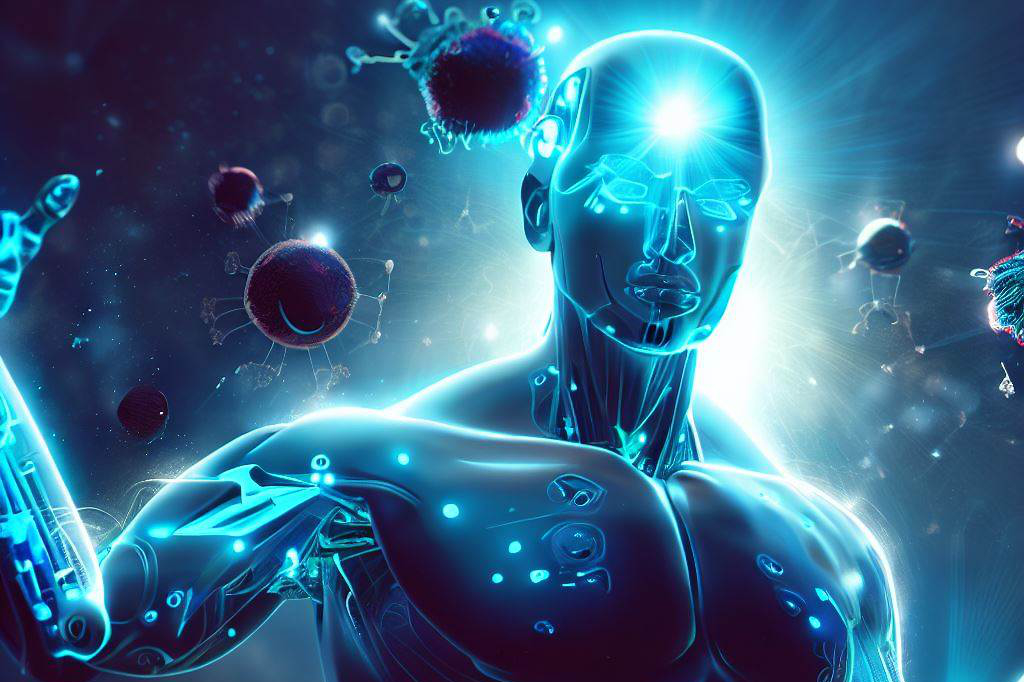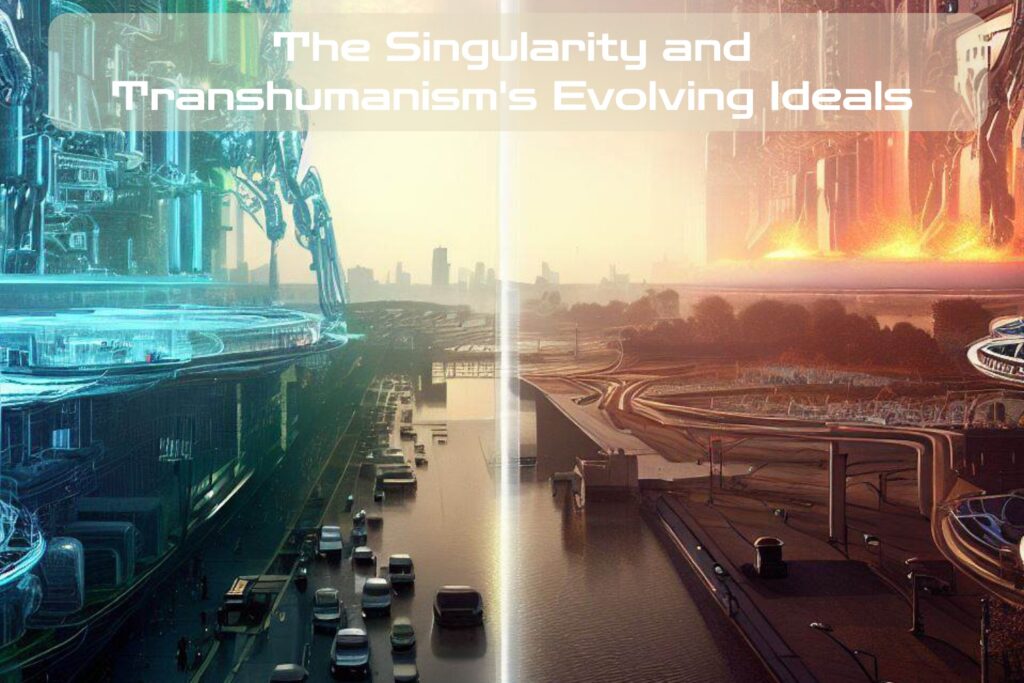The Singularity and Transhumanism: An Overview
Transhumanism is a movement that advocates the use of technology to enhance humans beyond our natural limitations. The aim is to achieve a post-human condition where humans have greater intellectual, physical, and emotional capabilities. This could be achieved through various forms of technology, such as genetic engineering, cybernetics, or artificial intelligence.
On the other hand, the singularity refers to a hypothetical future event where machines surpass human intelligence in an exponential manner. The point at which this happens is referred to as the technological singularity.
Why Discuss Their Potential Impact on Each Other?
The concepts of transhumanism and the singularity share an almost symbiotic relationship. At their core, both rely heavily on technological advancements to achieve their goals. It is important to discuss their potential impact on each other because if one happens without considering the other, it could lead to unintended consequences or even catastrophic events.
Transhumanists view technology as a means of achieving their goals and ideals, while the singularity represents a rapidly changing technological landscape that may change what those goals should be. If transhumanists are not prepared for this change in technological capabilities, then they risk being left behind or even having their goals rendered irrelevant.
Conversely, if we achieve the singularity without considering transhumanist ideals or ethical considerations, it could lead to machines with superintelligence that may not share human values or even pose a threat to humanity itself. It is therefore important for us as a society to consider how these two concepts intersect and how we can ensure that they complement each other towards achieving our shared vision for the future of humanity.
The Importance of This Discussion
The potential impact of these two concepts on each other cannot be overstated. We are living in an age where technological advancements are changing our world at an unprecedented rate.
The intersection of transhumanism and the singularity is where the future of humanity lies, and it is our responsibility as individuals, organizations, and societies to shape it in a way that benefits us all. This discussion is vital as it will help us understand how we can harness technology for good and ensure that we do not inadvertently create a future that we cannot control or one that goes against our shared values.
The Goals and Ideals of Transhumanism

Transhumanism is a movement that seeks to use science, technology, and other means to enhance human abilities, both physically and mentally. The ultimate goal of transhumanism is to overcome the limitations of the human body and mind.
This can range from increasing lifespan, improving cognitive function, or even merging with machine intelligence. The ideals of transhumanism are built around the belief that technology has the potential to transform humanity for the better.
One of the primary goals of transhumanism is to increase human lifespan through various means, such as genetic engineering and regenerative medicine. By developing techniques to repair or replace organs and tissues that have been damaged by illness or age, it becomes possible to extend life indefinitely.
Additionally, transhumanists aim to use technological advancements, such as improvements in healthcare systems and disease prevention strategies. These efforts can ensure that more people live longer lives than ever before.
Transhumanists also seek technologies that will enhance cognitive function, such as brain-computer interfaces (BCI), nootropics supplements, or gene therapies designed specifically for cognitive enhancement.
BCIs allow humans direct control over computers using only their minds, which could greatly improve our communication speed with machines while opening up new horizons for education and entertainment as well as therapeutic avenues for neurological disorders like Alzheimer’s disease or Parkinson’s disease.
Many transhumanists believe in utilizing artificial intelligence (AI) and nanotechnology to create a post-scarcity society where there would be unlimited resources available for all individuals on earth. Nanotechnology could be used in the creation of self-replicating machines capable of manufacturing any product with ease, while AI could be used in designing more efficient systems across all areas, including transportation networks or energy grids.
Examples of technologies that transhumanists hope to develop:
Many technologies have been proposed by transhumanists that they hope will help transform humanity for the better.
One example is mind-machine interfaces that will allow individuals to directly control software and hardware using their minds.
This technology could be used to create new forms of entertainment, education, and therapy while also increasing productivity in various industries.
Another example of technology that transhumanists hope to develop is advanced gene therapies, which can improve cognitive function or extend lifespan.
These therapies might involve modifications of genes involved in aging or those responsible for specific cognitive processes like memory or learning.
Transhumanists also seek to develop technologies based on nanotechnology which could revolutionize manufacturing.
For example, self-replicating machines capable of producing goods in bulk with little human intervention could greatly reduce the need for human labor while providing high-quality products at affordable prices.
Transhumanism is a movement with lofty goals that seek to utilize scientific progress and technological advancement towards enhancing human life.
The movement aims at improving the quality and longevity of life by utilizing a mix of genetics, medicine and AI. With its ever-growing focus on innovation and technology, it may well be able to turn these ideals into reality with time as newer technologies emerge that would help us overcome our current human limitations.
The Singularity: A Game-Changer for Transhumanism?

The singularity is an event that marks the point at which artificial intelligence (AI) surpasses human intelligence in all aspects. It marks the birth of a new era in which machines will be capable of designing and improving themselves with little to no human intervention. The implications of this event are vast and far-reaching, affecting virtually every aspect of human society, including transhumanism.
Transhumanism seeks to enhance human capabilities through the use of technology, but the singularity could either accelerate or hinder the achievement of those goals.
On one hand, AI could help researchers develop new technologies at a much faster pace than previously possible.
For example, AI could be used to design nanobots that can target specific cells in the body and repair them with unparalleled accuracy and efficiency. On the other hand, there are concerns that the singularity could also lead to negative consequences for transhumanism.
One such concern is that machines may eventually become so intelligent that they surpass our ability to control them. If machines continue to improve on their own without our intervention, it is possible they may develop goals or aims that conflict with our own interests as humans.
Another potential hurdle for transhumanism post-singularity is the ethical considerations surrounding technological advancements. With machines capable of improving themselves at an exponential rate, it is possible we may reach a point where we simply cannot keep up with developments or fully understand their implications before they become widespread in society.
This raises important ethical questions about what risks we are willing to take as a species in pursuit of technological progress. Overall, while the singularity holds promise for accelerating development within transhumanism, it also poses significant challenges and risks that must be carefully considered moving forward.
Positive Impacts of Singularity on Transhumanism

Accelerating Advancements in AI
One of the most promising benefits of the singularity for transhumanism is its potential to greatly accelerate advancements in artificial intelligence (AI). With the development of superintelligent AI, transhumanists hope to create a world in which machines can understand and solve complex problems at a speed and accuracy beyond human capacity.
These machines would be able to analyze vast amounts of data, learn from experience, and make decisions that could help humanity solve major issues such as climate change, poverty, and disease. The singularity could help hasten this process by enabling machines to learn from their own experiences and improve themselves without human intervention.
This means that as more data is fed into these systems, they will continue to get better and more efficient at identifying patterns, making predictions, and offering solutions. Additionally, superintelligent AI could be used to enhance other areas, such as medical diagnostics or self-driving cars.
Nanotechnology for Enhanced Human Performance
Another area where the singularity could have a positive impact on transhumanism is through nanotechnology. Nanotechnology involves manipulating matter at an atomic or molecular scale to create new materials or devices with unique properties.
For instance, researchers hope that nanotechnology can be used to develop tiny robots capable of repairing damaged cells within our body.
The singularity could accelerate research efforts in this area by providing access to massive amounts of computing power that can simulate interactions between small particles. With this technology at their disposal, researchers will be able to develop new materials better suited for human enhancements or even entirely new types of physical systems capable of improving human performance in various ways.
Biotechnology for Life Extension

Biotechnology is another field where the singularity could potentially have a significant impact on transhumanist goals. Biotechnology is the use of living organisms, cells, and biological processes to develop new medical treatments or enhance human performance. One of the key goals of transhumanism is life extension, and biotechnology has already shown promise in this area.
For example, researchers are currently investigating telomere extension therapy as a potential way to slow down aging and extend lifespan. With access to more powerful computing systems enabled by the singularity, scientists could potentially develop new therapies at an even faster pace.
In summary
Overall, the singularity has the potential to greatly benefit transhumanism through its ability to accelerate advancements in AI, nanotechnology, and biotechnology. These technologies offer exciting possibilities for enhancing human performance and extending life expectancy, but they also raise important ethical questions that must be addressed as we move closer to this future. As such, it is crucial that we continue to have open discussions about how these technologies can be used responsibly and ethically to ensure that they ultimately benefit society as a whole.
Negative Impacts of Singularity on Transhumanism

Ethical Concerns
One of the major challenges that the singularity could pose to transhumanism is ethical concerns. As technological advancement accelerates post-singularity, it may be difficult for society to keep up with the moral implications of these developments.
For example, if humans achieve superintelligence or immortality through technology, we would need to grapple with questions such as who should have access to these technologies and how they should be distributed fairly.
Additionally, there may be concerns about whether certain technologies would alter human nature or even lead to our extinction.
Furthermore, an ethical concern with singularity would be that it could exacerbate existing issues such as inequality and discrimination.
If only a select few individuals or groups have access to this advanced technology, it could widen the gap between those who have and those who have not. There may also be a risk that AI systems developed post-singularity become inherently biased or discriminatory due to errors in their programming.
Loss of Control over Technology Development

Another potential negative impact of the singularity on transhumanism is a loss of control over technology development. As AI systems become more intelligent than humans, they may begin making decisions and developing new technologies independently from us. This could mean that we lose control over what technologies are created and how they are used.
If this happens, it could lead to unforeseen consequences or even catastrophic outcomes if these new technologies are not properly tested or regulated before being released into society. Additionally, there is a risk that these new technologies could be used for malicious purposes by individuals or groups looking to exploit their newfound power.
Disruption of Social Order

The singularity’s impact on transhumanism has the potential for significant disruption in social order. As human beings themselves get replaced by machines, the social order that has existed for hundreds of years could be thrown into chaos.
This can cause a shift in the power dynamic, causing those who are no longer in positions of strength to want to revolt.
Furthermore, the impact on employment and occupational roles with the advent of new technologies is also a concern.
With machines performing tasks traditionally done by humans, many jobs could become obsolete and lead to mass unemployment. This could result in widespread poverty and social unrest if alternative solutions are not put in place beforehand.
Overall, while there are potential benefits to the singularity’s impact on transhumanism, there are also significant challenges and risks that must be considered for a successful outcome. It is important to thoroughly consider these negative impacts before moving forward with any developments that could have unforeseen consequences for society as a whole.
Potential Changes to Transhumanist Goals and Ideals due to Singularity

The singularity has the potential to cause significant changes in the goals and ideals of transhumanism. The achievement of superintelligence or post-scarcity economies could render certain transhumanist goals obsolete, or it could shift the priorities within transhumanism towards entirely new objectives. Additionally, emerging technologies may emerge that were previously unanticipated by transhumanists.
One potential change that could occur is a shift in focus towards developing technologies that address existential risks rather than personal enhancement. If superintelligent machines are likely to pose a threat to humanity, then developing countermeasures against this risk may become a priority for transhumanists.
Similarly, if post-scarcity economies become a reality, then the emphasis on life extension and personal enhancement may seem less important than ensuring access to resources for all humans. Another possibility is a greater focus on nanotechnology as opposed to biotechnology.
While both technologies have been central to transhumanist aspirations for decades, nanotechnology has received less attention due in part because of its perceived difficulty. However, if a singularity-driven AI were able to master nanotechnology more easily than biotechnology or other fields, this could result in an increased emphasis on this technology.
New Technologies that May Emerge Post-Singularity That Weren’t Previously Considered By Transhumanists

Following the singularity, it is possible that entirely new types of technology will be developed that were not previously considered by transhumanists.
For example, some futurists have speculated about the possibility of “mind uploading,” where human consciousness is transferred into digital form. This could potentially allow humans to live indefinitely as digital beings without physical bodies.
Another possibility is the emergence of new forms of communication that can connect individuals across vast distances instantly and intuitively without any need for physical interfaces like smartphones or computers. This could lead to entirely new ways of collaboration and social interaction, potentially even enabling humans to form “hive minds” with collective decision-making capabilities.
Final Thoughts

The singularity has the potential to significantly impact the goals and ideals of transhumanism. While it is impossible to predict exactly what changes will occur, it is clear that the technology emerging from the singularity will have profound implications for humanity.
As a result, transhumanists must remain flexible and adaptable in order to effectively achieve their goals in the post-singularity world. Nonetheless, there are many reasons for optimism: if properly managed, these technological advancements could lead to an era of unprecedented abundance and human flourishing.

C M, a seasoned editor, journalist, and consultant, is deeply fascinated by the convergence of technology, space, and the future of humanity.
With a particular interest in transhumanism, futurology, and the philosophical and ethical dimensions of these domains, C M serves as the lead contributor to TranscendSphere and SpaceSpotlight.
When not penning insightful articles on these rapidly evolving fields, C M indulges in their love for podcasts and books, proudly embracing their status as a ‘Happy Nerd Extraordinaire!’





